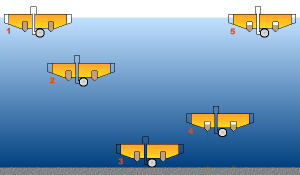Introduction
Like many people, I have been watching BP try to cap the blown Deepwater Horizon oil well. While BP has had many issues, it has been very interesting watching the unmanned underwater vehicles (UUVs) do their job. When most people think of underwater vehicles they think of World War II submarines or one of the manned underwater vehicles that were used to explore Titanic. In today's world, most UUVs are busy quietly doing real work every day. Seeing these vehicles in action brought to mind some fond memories.
History
At one time in my career, I worked on UUVs and it was some of the most satisfying work of my career. I have always been fascinated by the history of undersea exploration. Most of this history has been about designing vehicles to take people to very inhospitable places. The topic of this article is the bathyscaphe, which is a manned vehicle that was designed to take people to the deepest depths. It is a vehicle of a time past.
My first and only direct contact with a bathyscaphe was on one of my business trips. While on a trip to Keyport, WA, I happened to stop by a wonderful museum, the Naval Undersea Museum. I highly recommend stopping by this museum if you have any interest in the sea. On this trip, I took particular note of their display of the bathyscaphe Trieste II. It is a heavily modified version of the Trieste I, the submarine that made the only manned trip to the deepest point in the ocean, Challenger Deep in the Marianas Trench. In fact, the Trieste II used the original pressure sphere from Trieste I, which is where the two-person crew resided while diving.
When I was a boy in the 1960s, I read about the bathyscaphe Trieste I and its brave crew, Jacques Piccard and Don Walsh. Their voyage had some scary moments, like when their glass viewing port cracked during the dive. If that port had let water in, there was no hope for their survival. However, they persevered and completed their mission. Their voyage also confirmed that life was present at the deepest point in the ocean. For those interested in more information on the mission, I recommend the Wikipedia’s exposition. There is also a very interesting web site that specializes in the Walsh/Piccard mission
How a Submarine Works
A typical submarine that works at relatively shallow depths usually has ballast tanks that can be filled with water. A submarine dives or surfaces by applying Archimedes' Principle, which states that an object sinks or floats based on its density relative to water. In the case of a submarine, as the ballast tanks fill with water, the submarine density of the submarine increases and it dives. To rise, compressed air is used to clear the tanks of water. As the water is removed, the density of the submarine decreases, and the submarine surfaces. The problem with this approach for an underwater vehicle is that the ballast tanks must be built sturdy enough to ensure that the pressure outside the tanks cannot crush them. This means big, heavy, and expensive tanks.
How a Bathyscaphe Works
A bathyscaphe works differently than a submarine. Because it works at extreme depth, the only air spaces on the vehicle are for the crew. From a buoyancy standpoint, a bathyscaphe is similar to a hot air balloon in that it uses contains a buoyant fluid (aviation fuel) in a lightweight enclosure to provide lift. The nice thing about aviation fuel is that it is incompressible and that means that it will resist the intense pressure. To sink, a bathyscaphe is filled with aviation fuel for buoyancy and iron shot for ballast. Enough iron shot is put on-board to ensure it can dive. When the bathyscaphe wants to surface, it releases the iron shot. To quote the Wikipedia, "Strictly speaking bathyscaphes are not submarines because they have minimal mobility and are built like a balloon, using a habitable spherical pressure vessel hung under a liquid hydrocarbon filled float drum." The following figures from Wikimedia Commons do a nice job illustrating how a bathyscaphe works.
Why No More Bathyscaphes?
While bathyscaphes are interesting, no one builds them anymore. Why? I am an electrical engineer by training, but I was very curious about how these research vessels are designed. As part of my job, I worked with an excellent team of mechanical engineers that were designing the structures (pressure vessels, control surfaces, etc) for the underwater vehicles we were building. So I decided to ask the lead engineer of this very knowledgeable group "Why no more bathyscaphes?" He gave me a two-word answer ― "syntactic foam". A syntactic foam is basically a plastic material that is filled with a large number of tiny hollow spheres. The spheres can be made of various materials. In my case, they were glass. These spheres are very strong so that they can resist extreme pressures. They are also very light and easy to work with. They also provide a substantial amount of buoyancy. The polymer material binds all the spheres together; hence the term "syntactic," which means to "put together." The vehicles we were working on had a lot of foam. I noticed that all modern deep-diving submarines use syntactic foam (see Alvin for example). Now I understood why no one builds bathyscaphes anymore -- the foam is much cheaper and more convenient than aviation fuel when it comes to flotation. More importantly, it is also much safer because gasoline can leak from the tanks (see Bob Ballard story below).
Underwater Adventure
I have heard syntactic foam and bathyscaphes mentioned in the news.
Bathyscaphes in the News
Do not ever pass up an opportunity to hear Bob Ballard speak on science. He is absolutely the best. I was listening to him on the radio one day and he told a hair-raising story about a trip he took on a bathyscaphe. While down deep, a leak developed and the gasoline began to leak out. Now think about this ― the gasoline is like the hot air in a hot air balloon. If the hot air leaks out of a balloon you sink to the ground. If the gasoline leaks out of a bathyscaphe, you sink to the bottom of the ocean. Ballard related how they sweated out the long trip back to the surface hoping that they would have enough gasoline to get them to the surface. If they were to leak gasoline too quickly, they would end up on the bottom of the ocean — and no one else could dive deep enough to help recover them. Fortunately, everything worked out. But this illustrates how dangerous undersea exploration was in the early days. Here is a link to a PBS video where he relates the same story.
Syntactic Foam in the News
It may be hard to believe, but I actually heard a scientist on a documentary talking about syntactic foam. He was serving on the Alvin when it filmed vulcanism down at the mid-Atlantic ridge. The scientist was actually on the submarine and was reading the temperature of the water outside. As the temperature rose, an engineer mentioned to him that the outside temperature was hot enough to melt the syntactic foam and they should get to a cooler area. The scientist immediately agreed and they pulled out of that area.
On May 31, 2009, the robot submarine Nereus went to the bottom of Challenger deep. The craft they sent used a new kind of buoyancy system using ceramic spheres in place of syntactic foam.




hi i liked this reading thanks to you i am now very intrested in this bathyscaphe i found it on my book and searched it up i put why cant we make anymore bathyscaphe's and found this very intresting website thank you by :me jon
Hi Jon,
Thanks for reading my blog post. I hope you can someday get out to Keyport WA and see a real bathyscaphe.
mark
Very interesting read. My sister lives in Seattle and maybe when I go to visit, I can learn more about the Bathyscaphe in Keyport.